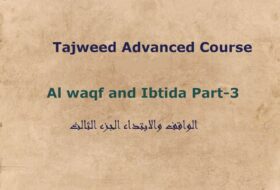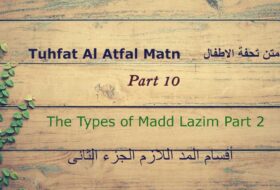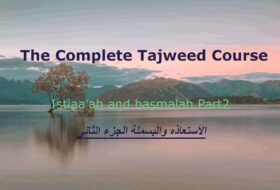The Types of Madd Lazim أقسام المد اللازم
See:-> Part-1 Part-2 Part-3 Part-4 Part-5 Part-6 Part-7 Part-8 Part-10 Part-11
اقسام المد اللازم
أَقْسَـــــامُ لازِمٍ لَدَيْهِمْ أَرْبَعَهْ وتَلْكَ كِلْمِـــيٌّ وَحَرْفِيٌّ مَعَـهْ
كِلاهُمَـــــــا مُخفَّفٌ مُثَقَّلُ فَهَذِهِ أَرْبَعَـةٌ تُفَصَّــــــلُ
فإِنْ بِكِلْمَـــةٍ سُكُـونٌ اجْتَمَعْ مضعْ حَرْفِ مَـدًّ فَهْوَ كِلْمِيٌّ وَقَعْ
أَوْ فِي ثُلاثِيَّ الحُروُفِ وُجِــداَ وَالمَدُّ وَسْطَـهُ فَحَرْفِـــيٌّ بَدَا
كِلاهُماَ مُثَقَّـــــلٌ إَنْ أُدْغِماَ مُخَفَّّفٌ كـُلٌ إذَا لَمْ يُدْغَمَــــا
TEXT: 48
أَقْسَـــــامُ لازِمٍ لَدَيْهِمْ أَرْبَعَهْ وتَلْكَ كِلْمِـــيٌّ وَحَرْفِيٌّ مَعَـهْ
VOCABULARY:
أَقْسَـــــامُ – types
لازِمٍ – referring to Madd lazim
لَدَيْهِمْ – according to them i.e. according to the Qurraʾ
وتَلْكَ – it is (the types of Madd lazim)
كِلْمِـــيٌّ – stems from the word كلمة which means word. It may be read with a fatḥah or kasrah on the kaf.
وَحَرْفِيٌّ – stems from the word حرف which means letter
َْمَعَـهْ – with it i.e. with كلمى
TRANSLATION:
48. The types of lazim according to them (the qurrāʾ) are four; and it is kilmī and ḥarfī with it.
COMMENTARY:
Madd lazim is divided into four types. Initially they are of two types: kilmi and ḥarfi The author will explain what kilmī and ḥarfī is later .
TEXT: 49
كِلاهُمَـــــــا مُخفَّفٌ مُثَقَّلُ فَهَذِهِ أَرْبَعَـةٌ تُفَصَّــــــلُ
VOCABULARY:
َكِلاهُمَـــــــا – both of them (kilmī and ḥarfī)
مُخفَّفٌ – stems from تخفيف which means light
مُثَقَّلُ – stems from تثقيل which means heavy
تُفَصَّــــــلُ – will be explained.
study with our online Academy Tajweed and Quran
TRANSLATION:
49. Both of them (kilmī and ḥarfī) are mukhaffaf and muthaqqal, so these four (types of lāzim) will be explained.
COMMENTARY:
In the first line the author explains that Madd lazim is divided into kilmi and ḥarfi.
In this line he states that kilmi and ḥarfī are further subdivided into mukhaffaf and muthaqqal. In this manner lazim has four types as illustrated in the diagram below:

In the next three lines the author explains what kilmī, ḥarfī, Mukhaffaf and Muthaqqal are.
TEXT: 50
فإِنْ بِكِلْمَـــةٍ سُكُـونٌ اجْتَمَعْ مضعْ حَرْفِ مَـدًّ فَهْوَ كِلْمِيٌّ وَقَعْ
VOCABULARY:
فإِنْ – So when
بِكِلْمَـــةٍ – in a word
اجْتَمَعْ – joins, meets, comes together
حَرْفِ مَـدًّ – a Letter of Madd
فَهْوَ – then it is
وَقَعْ – occurred, taken place .
TRANSLATION:
50. So when, in a (single) word, a sukun meets a letter of Madd, then it is kilmi that has occurred.
COMMENTARY:
In this line the author outlines what kilmī is: if a letter of madd is followed by a Sukun in one word then kilmi has taken place.
It is obvious that the Sukun being spoken about is a permanent Sukun or else it will not be lazim e.g. دابّة – أتُحاجُّونَنا

TEXT: 51
أَوْ فِي ثُلاثِيَّ الحُروُفِ وُجِــداَ وَالمَدُّ وَسْطَـهُ فَحَرْفِـــيٌّ بَدَا
VOCABULARY:
ثُلاثِيَّ – tripled letters, trilateral letters i.e. consisting of three letters
الحُروُفِ – the letters. Plural of الحروف , which means the letter
وُجِــداَ – they are found. It is dual, referring to two things, the letter of Madd and the sukun.
وَالمَدُّ – the madd i.e. the letter of madd
وَسْطَـهُ – it’s centre. It may be read with a fatḥah or a ḍammah on ط
بَدَا – clear / apparent / appeared
TRANSLATION:
51. Or in the tripled letters they (the letter of madd and the sukūn) are found, while the (letter of) madd is in its centre, then ḥarfī is clear.
COMMENTARY:
What is meant by الحروف in this line are the cut letters ( الحروف المقتطعات ) which are found at the start of certain ٍSurahs in the Quran.
Only those Huruf al-Muqaṭṭaat, which consist of three letters are particularly mentioned here. Furthermore, of the three letters (in the ḥurūf al-muqaṭṭaʿāt), the middle letter must be a letter of madd.
Thus if in the ḥurūf al-muqaṭṭaʿāt, the letter of madd (being the center letter) is followed by a (permanent) sukūn then it will be ḥarfī as known ( نون – صاد)
The Connecting Hamzah (Hamzah Alwasl) Part3
TEXT: 52
كِلاهُماَ مُثَقَّـــــلٌ إَنْ أُدْغِماَ مُخَفَّّفٌ كـُلٌ إذَا لَمْ يُدْغَمَــــا
VOCABULARY:
إَنْ أُدْغِماَ – if idgham takes place
كـُلٌ – each one of them (kilmi and ḥarfī)
إذَا – if
لَمْ يُدْغَمَــــا – no idgham occurs
TRANSLATION:
52. Both (kilmī and ḥarfī) are muthaqqal if idgham takes place. Mukhaffaf, each one of them, if no idgham occurs.
COMMENTARY:
After explaining what kilmī and ḥarfī is, the author expounds upon what muthaqqal and mukhaffaf are.
If idghām takes place, it will be muthaqqal, in which the letter of madd is followed by a letter which is mushaddad. Therefore it is called muthaqqal (heavy) since a mushaddad is regarded as a “heavier” (more difficult) pronunciation than a sākin e.g. الضَّالِّينَ –الم













